
Galveston lies at the eastern end of an island about two miles off the Texan coast, with one side of the city touching the shores of the Gulf of Mexico and the other side built upon a sandbar that today fronts Galveston Bay and the port area. It has a very mild, sub tropical climate that makes its beaches popular with tourists. The major cargoes over the almost two hundred years since the area was designated as a port in 1825 have included cotton, grain, petroleum of both crude and refined types, wheat, flour, rice, oil cake, sulphur, iron and steel products, machinery, ores and metals, lumber, containers and ro-ro cargoes of all types including project and heavy lift ‘outsize’ cargo.
Galveston has survived a Category Four Hurricane that ripped the wooden houses apart on 8th September 1900, with everything destroyed in a storm surge flood that killed over eight thousand residents and left ships stranded in agricultural fields over two miles inland amidst a sea of timber wreckage. Only one house was left standing in a precarious state, with high concrete walls then built as protection from the sea. It also survived a ‘Wall of Fire’ on 23rd December 1920 when an entire dock filled with oil barges unloading oil via numerous pipelines caught fire in a terrific detonation, with one American steamer lost to the blaze and a British steamer only just escaping at full speed from the dock although badly damaged and burned by the fire.
History of Galveston
Galveston Island was discovered by the Spanish explorer Juan de Grijalva in 1519, while a compatriot, Cabeza de Vaca, was shipwrecked on ‘Malhado’, an island believed to have been Galveston nine years later. The first settlement was established on 13th September 1816 by the French privateer Louis-Michel Aury, who was sent as the Mexican Governor of Texas to create a port from which to launch an attack against royalist coastal towns and also to attack Spanish shipping. A year later, while Aury was away in Mexico, the pirate Jean Lafitte made Galveston Island his base of operations, and created a fortified village and named it Campeche. The small village contained the pirate hovels and huts, a slave market, boarding houses for visiting buyers of slaves, a shipyard, pool halls, gambling houses, brothels and a mansion for Lafitte named ‘Maison Rouge’.
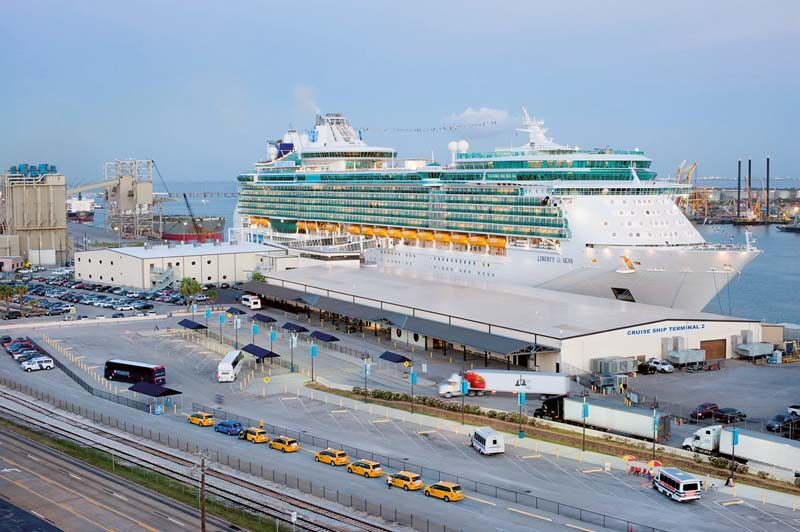
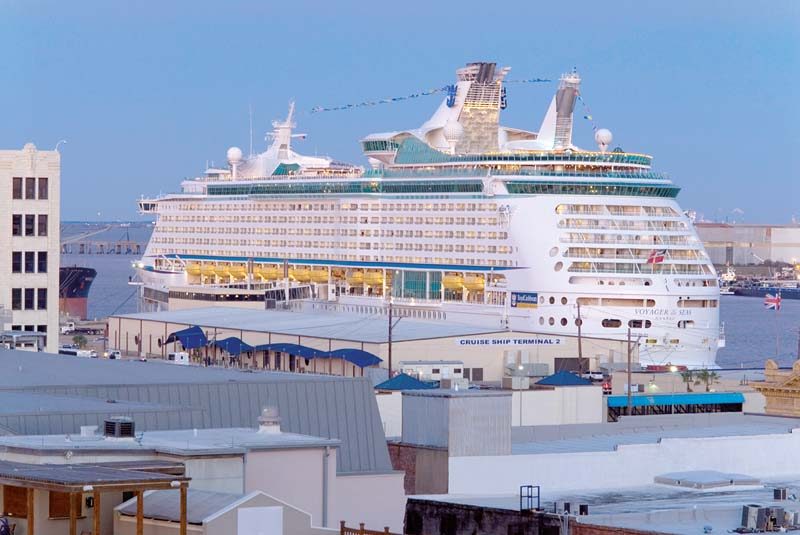
Today, the port area covers 850 acres, and it is hard to believe that it was established on 17th October 1825 by a proclamation issued by the Congress of Mexico with only a customs house to serve a provisional port. The land known as Texas still belonged to Mexico at this time, with Texas becoming a State of the United States of America in 1845. Galveston is thus the oldest port in the Gulf of Mexico area to the west of New Orleans. The Texas Navy had made Galveston its homeport ten years earlier in 1835, before the ‘Lone Star’ State had been officially recognized. The Congress of the United States of America declared the Port of Galveston as a ‘Port of Entry’ in 1837, appointing the first Collector of Customs. Warehouses and dock areas were then built, and a charter from the State of Texas in 1854 brought these various port interests together in a company known as the Galveston Wharf and Cotton Press Company.
The American Railroad companies arrived at the port in 1860 after a railroad bridge was completed from the mainland to Galveston Island. Until the railroad, goods on trains were unloaded on the mainland side on to a steam ferry and then transported to the island side where they were unloaded into drays pulled by horses and taken to the port wharves for reloading onto ocean going ships. By 1873, the Gulf, Colorado and Santa Fe Railroad was the principal railroad serving the port, bringing in cotton for export from the newly built Cotton Exchange. The Galveston District of the U.S. Corps of Engineers was established in 1880 to actively build up the port and to serve the Texas Gulf Coast. One of their first projects was to deepen the natural channel and build two stone breakwaters, one on each side of the narrow entry point known as ‘The Gorge’. The eastern breakwater stretched out from a narrow sandy peninsula known as Bolivar Island, with the two breakwaters thus enclosing the Bay of Galveston. By 1900, Galveston was the leading American port for the export of cotton, and the third most important port for the export of wheat from the grain elevator at Pier 16/18. There were twenty piers in operation by 1900 in a port whose residents were confident of their future as a premier and major port on the Texan coast.
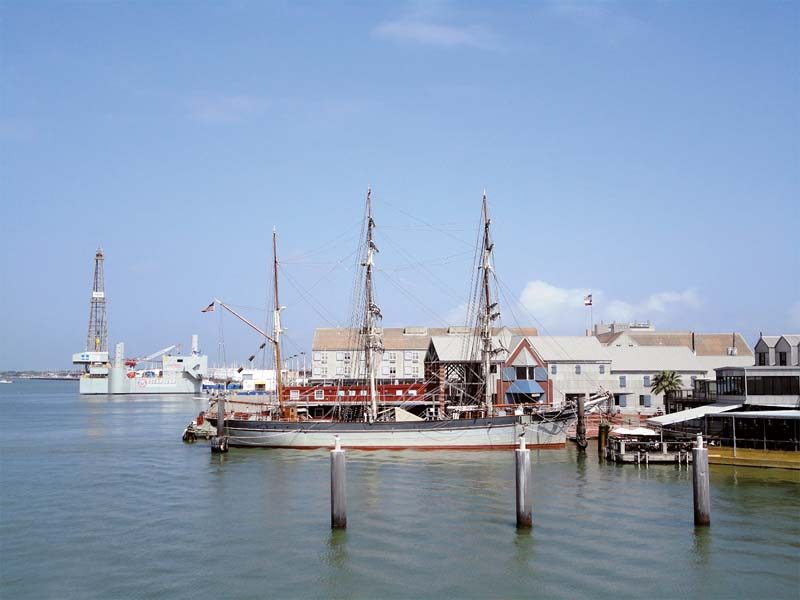
Galveston Destroyed By Hurricane
A Category Four Hurricane on the Saffir-Simpson Hurricane Scale crossed Cuba on 4th September 1920 and headed in a straight north west direction for Galveston Bay. The people of Galveston felt no alarm when an official hurricane warning was issued on 7th September, as their long flat island city at only eight feet above sea level had weathered all previous storms. However, on the next morning a hurricane and storm surge of fifteen feet roared over the town and carried every timber building before it and smashed them into seas of timber debris miles in length. The death total was over eight thousand with some reports putting the total at nearer twelve thousand. This made the hurricane the most deadly natural disaster ever in American history. In comparison, the Okeechobee hurricane of 1928 caused 2,500 deaths, and Hurricane Katrina that devastated New Orleans in 2005 claimed the lives of only 1,800 people.
The first train to reach Galveston left Houston on the morning of 8th September at 0945 hours, but was stopped by the sea of timber debris as it tried to cross the washed out railroad bridge to the island, eventually forcing passengers to transfer to a relief train to complete their journey at a snail’s pace on a parallel track. On the east side of Galveston Bay, another train carrying 95 passengers from Beaumont via Bolivar Island made it to ‘The Gorge’, the entry point for Galveston, to await the ferry that would take them all and their train to Galveston. However, the ferry captain on arrival found he could not dock due to the high seas then running, forcing him to give up the attempt. The train crew attempted to return the way they had come, but swirling water on the track blocked their way. 10 refugees from the Beaumont train sought refuge in the Point Bolivar Lighthouse along with all of the 200 residents of Bolivar Island settlement, however the 85 remaining train passengers died when the storm surge of water crashed over the top of the train.
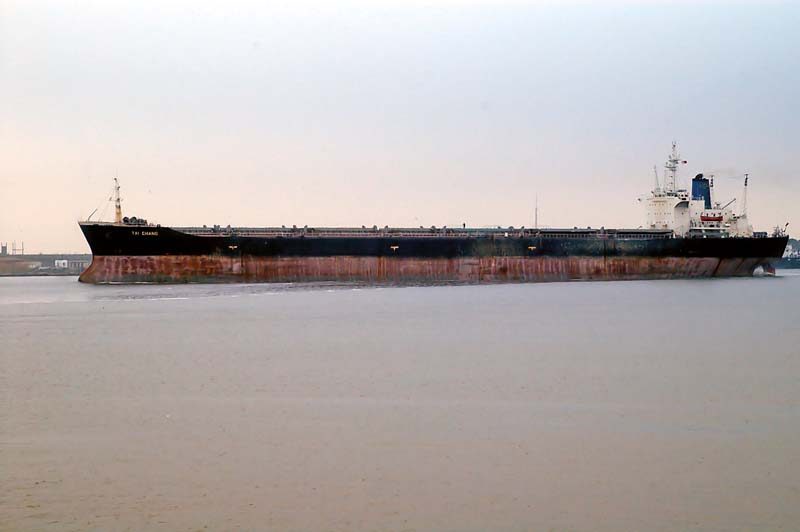
The hurricane wind speed reached 160 kilometres per hour at 1800 hours with the eye of the hurricane passing over the destroyed city two hours later. Maximum wind speeds then reached 190 kilometres per hour when the storm picked up its deadly destruction once again. Word of the total loss of the city and almost all of its residents took some time to reach Houston, as all bridges and rail causeways had been washed away. The steamer Pherabe had fortunately weathered the storm surge at one of the Galveston piers, and arrived at 1100 hours on 9th September at Texas City on the western side of Galveston Bay with six survivors from Galveston. The survivors then continued on northwards to the telegraph office at Houston, arriving at 0300 hours on 10th September to send a message to Texas Governor Joseph D. Sayers and U.S. President William McKinley to inform them that Galveston no longer existed and that a large percentage of the residents had been drowned and that the Port of Galveston had been destroyed.
Rescue workers set off immediately from Houston by ship for Galveston, but attempts at rescue were futile as the city had been destroyed, making it impossible to wade through the sea of timber debris to reach survivors, with many more residents dying in the wreckage during the coming days.
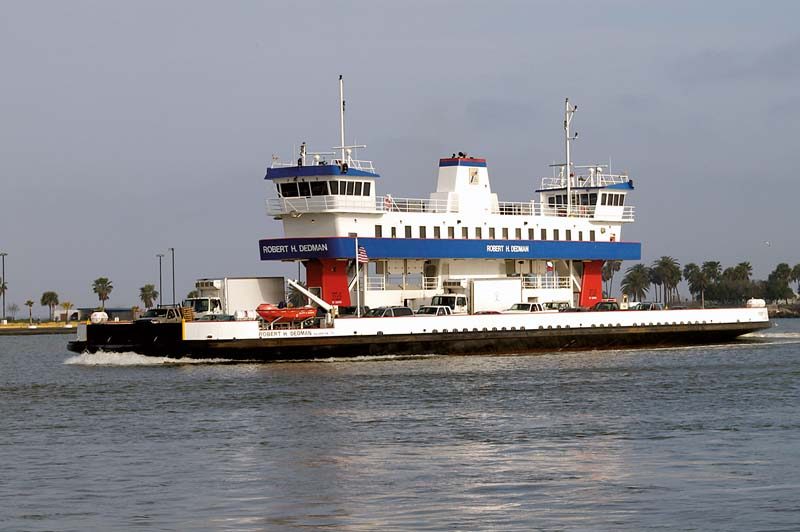
The rescuers could hear the screams of survivors but were unable to reach them, and the stench of dead bodies was everywhere, leading to barges being called in to dump them into the sea outside the port. Funeral pyres were set up on the beaches or wherever bodies were found, and burned day and night for several weeks after the hurricane had passed. The death total was enormous and was by far the deadliest of almost three hundred hurricanes that have since roared through the Caribbean and the Gulf of Mexico and Florida areas.
Galveston took many years to recover from this deadly hurricane, as business and residents moved north to Houston away from the coast, and the dredging of the Houston Ship Channel in 1909 and again in 1914 ended the hopes of Galveston to regain its premier position on the Gulf of Mexico. High concrete sea walls of seventeen feet in height were quickly constructed at Galveston to help the rebuilding of the city and port, and massive quantities of dredged sand was used to raise the elevation of the new buildings by the same height.
These much needed sea defences were tested to their limits when another hurricane roared through in 1915 with a twelve feet high storm surge, causing the deaths of another 53 residents of Galveston Island. This high seawall has today been extended to more than ten miles in length to protect the city and the port. Although the Port of Galveston had reopened after a complete rebuild to have up to 28 piers in operation by 1920, Galveston was still considered a dangerous place to live for generations afterwards.
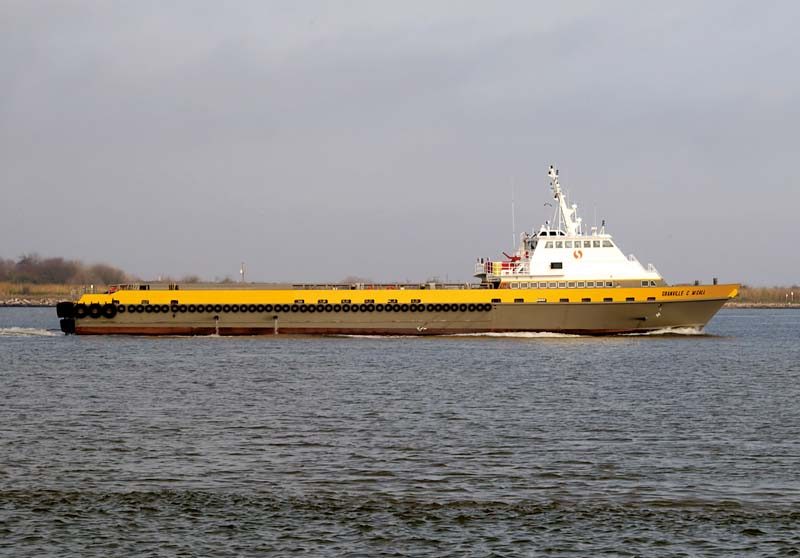
‘Wall of Fire’ at Galveston
At 1400 hours on Thursday, 23rd December 1920 an oil barge blew up with a terrific detonation at Slip A in the Port of Galveston. Oil hoses and pipelines then ignited spontaneously along both sides of the slip, with dense fire and smoke blocking visibility. Subsequent efforts by four tugs to tow away the American steamer El Occidente failed and she was consumed in the catastrophic blaze. The captain of a British steamer faced the equally imminent destruction of his ship named Aschenburg, a British prize in 1919 from Germany and a former Hansa Line big steamer of 9,000 tonnes deadweight with six capacious holds in her long hull of 470 feet. She had just completed loading a full cargo of grain at the landward end of the slip, and was awaiting the pilot when an oil barge blew up in front of her bow. There was no time to wait for the pilot on the new pilot cutter Texas of 201 grt completed in 1919 for the Galveston-Texas City Pilots. Capt. McKenzie could not allow his fine ship to come to such an ignominious end, and immediately ordered the bow and stern ropes to be slipped. Speed was quickly worked up by the efforts of the stokers and the Chief Engineer, with Aschenburg then running into a wall of red fire. She made it through, but the canvas hatch covers on the forward holds, derrick guy ropes, oily winches and the wooden front of the bridge were all well alight as she attempted to gain the deep channel, her steam whistle lanyard constantly blowing to warn any other ships.
A port fireboat and the crew of the Aschenburg managed to bring her many fires under control and she berthed safely at the vacant Pier 28, after being briefly aground in the mud of the main channel. All two dozen glass portholes in the crew accommodation had been blown out by the force of the heat and flames, and it took eight days of repairs to her shattered hull and bridge, with many buckled steel plates removed and replaced, before she could be said to be seaworthy once again. She sailed on 31st December 1920 for Hamburg, where permanent repairs were put in hand by her managers Rankin, Gilmour & Company of Liverpool, acting on behalf of the British Government. Almost immediately after completion of repairs, she was purchased by Ellerman Lines and placed in their regular Bucknall Line service to South Africa and renamed Lorenzo. She was renamed City of Christchurch in 1929 and gave 23 years of service to Ellerman Lines until lost to enemy action in 1943.
Inter-War Years
Petroleum, grain and cotton continued to be the main cargoes of the rebuilt Port of Galveston, and of the Port of Houston, and the big oil port of Port Arthur, located fifty miles to the east of Galveston during the inter- war years. Galveston, Houston and Port Arthur all received large quantities of oil by pipeline from the interior, and exported it, both crude oil and refined products, coastwise to American ports in the north and also to foreign ports. Grain Elevator B was commissioned in the Port of Galveston in 1930 and quickly managed to set national and port records for the export of grain received from the ‘grain belt’ of the Mid West States. The channel at the Port of Galveston had been deepened to thirty feet, and had a favourable export trade in grain to balance the need of deadweight cargo when carrying a lightweight cargo of cotton. Three quarters of the cotton arrived from the State of Texas, with the remainder from Louisiana, Tennessee, Oklahoma and Arkansas. The Imperial Sugar bulk handling terminal handled imports of sugar and molasses. The combined import and export figures for the three Ports of Galveston, Houston and Port Arthur in 1930 were as follows:-
COMBINED FOREIGN EXPORTS (TONS)
| Crude Oil & Refined Products | 5,000,000 |
| Cotton | 950,000 |
| Wheat | 850,000 |
| Sulphur | 670,000 |
| Flour | 111,000 |
| Rice | 30,000 |
| Oil Cake | 70,000 |
| Iron and steel | 150,000 |
| Machinery | 120,000 |
| Ores and metals | 170,000 |
| Timber | 150,000 |
| TOTAL | 8,271,000 Tons |
COMBINED FOREIGN IMPORTS (TONS)
| Crude Oil & Refined Products | 500,000 |
| Sugar and Molasses | 170,000 |
| Iron Ore and Manganese Ore | 150,000 |
| Iron and Steel goods | 70,000 |
| Fertilizers | 50,000 |
| Fruit and bananas | 50,000 |
| Copra | 50,000 |
| Coffee | 10,000 |
| Jute and fibres | 40,000 |
| TOTAL | 1,090,000 Tons |
Post-War YEARS
The citizens of Galveston had determined in a vote during the war years that the private interests controlling the Galveston Wharf Company should be sold to the City of Galveston, and their piers and properties became known as the Galveston Wharves. Grain exports set a national record for exports from a single port in 1951, helped by the big Grain Elevators A and B. A rail and vehicular causeway was completed in 1954 connecting Galveston Island to Pelican Island at a cost of $6 million. In 1962, the citizens of Galveston approved the issue of $12 million worth of bonds for the improvement of the facilities of the Port of Galveston. The money was put together with $8 million from Galveston Wharves surplus revenues for aport rehabilitation project of $20 million.
Galveston became the first Texan port in 1965 to win the President’s ‘E’ award for Export Trade Development for outstanding contributions to the increase of U.S. trade abroad. The port now covered three hundred acres and was valued at $35 million. In 1969, the port purchased the 50 acres of land known as the Seabee Terminal Property for £278,000. The West Indies Shipping Company, a subsidiary of Del Monte Corporation, began bringing in banana imports to the Port of Galveston. Duval Corporation opened a $9 million sulphur exporting facility in the port complex, and a further 185 acres of land on the north east side of Pelican Island was purchased for $61,000 in 1970.
The Port of Galveston Container Terminal opened for business in 1972 after two years of construction at a cost of $7.7 million. The purchase of a container crane, straddle carriers and other container handling equipment was also included in the total, as was also the construction of new Seabee facilities on Pelican Island. Container lines using the terminal include COSCO, ‘K’ Line and Yang Ming Line. The first cruise ship docked in the Port of Galveston during 1974, with a project underway that year to deepen the Galveston Channel from 36 feet to 40 feet. Cook Industries completed a new Grain Elevator in 1976 at a cost of $26 million, and their Grain Elevator C was purchased by the Farmers Export Company a year later.
Destruction of Grain Elevator and Silos
A disastrous explosion destroyed the greater part of Grain Elevator C in 1977 and parts of the adjacent silos, the damage took three years to repair with the grain elevator back in service in August 1980. The explosion occurred during the late afternoon of 27th December 1977 at Pier 33, a cluster of forty silos with a capacity of 3.5 million bushels. 10 workers were killed, a dozen more were seriously burned, and 35 other victims were hospitalised. The ear shattering blast was heard seventy miles away in the second such grain elevator explosion in the U.S.A. in a week, the first killed 35 workers. Thick concrete dust hung in the air and was deposited on the ground after the ball of fire and explosion, with two workers later freed at midnight and taken to hospital in Houston. The cause of the blast was never discovered at the subsequent inquiry.
Pier 19 was taken out of commercial service in 1977 after a referendum of local residents, and was then used for the berthing of shrimp boats, party boats, small fishing boats, and retail fish sales outlets. The Todd Galveston Dry Docks Inc. site at Pelican Island, just inland from Galveston Island, had built a dozen T1-M-A1 coastal tankers of 1,184 grt during the war between September 1943 and October 1944, followed by three ships in 1950 comprising two ferries of 588 grt and the conversion of landing craft LST885 into the Great Lakes cargo ship Gaspedoc. The Port of Galveston purchased this former Todd repair yard in 1993 for six million dollars, and created Foreign Trade Zone #36 on Pelican Island and Galveston Island. The port then leased 109 acres of Pelican Island to PMB/Bechtel, and it is currently operated by Gulf Copper Drydocks and Rig Repair to maintain and repair vessels and offshore rigs. Alongside water depths vary from 7.6 metres to 12.2 metres and the dry dock lift capacity is 60,000 tons. The facility offers construction, repair, engineering, modification and environmental services to the offshore oil industry to build all kinds of rigs and modules.
Galveston Cruise Ship Terminals
The first day cruise operation began from a Galveston pier in December 1989, and the new Galveston Cruise Ship Terminal was opened in the following year at a cost of $2.4 million. The Terminal comprises two cruise ship berths, Numbers 1 and 2, located at 2702 Harborside Drive between Grain Elevator C and Pier 22, which has a berth for the 1877 iron hulled sailing ship Elissa as well as the Fisherman’s Wharf Restaurant and other restaurants, cafes and retail outlets. The Port of Galveston Administration Office is located on the eighth floor of a building overlooking the two cruise terminals, which are linked to Interstate Highway 45 four miles away. The main cruise lines operating from the two cruise terminals are Carnival Cruise Line, Disney Cruise Line, Royal Caribbean International, Princess Cruises, and Celebrity Cruises, the latter operating eleven and twelve day cruises from Galveston to the Panama Canal from the refurbished Cruise Terminal 2, updated in 2004 at a cost of seven million dollars. The expenditure was needed as one million cruise passengers had passed through the Port of Galveston from the Millennium to 2004. Carnival Cruise Line offer four and five day cruises to Cancun and other ports in Mexico, and Royal Caribbean International offer seven day cruises to the Western Caribbean.
Port of Galveston Current Piers
Pier 10 has two berths of total length of 410.3 metres and an alongside depth of 12.2 metres with a surface area of 15.4 hectares with good rail links and a ro-ro ramp. Lykes Brothers vacated the berths and their container and general cargo ship operations in 1995 to make Pier 10 into a multi-user cargo operations facility.
Pier 14 is the Port of Galveston Marine Repair Terminal on Pelican Island and is operated by Malin International Ship Repair and Dry dock Inc to maintain and repair vessels and oil rigs. The Pelican Island Storage Terminal is operated by a company of the same name to store and tranship liquid bulk cargoes. Tankers, both coastal and deep sea, and intracoastal barges berth here, and the terminal has a storage capacity of 125,000m3 and an alongside depth of 12.2 metres. Bunker heavy oil fuel and diesel are available.
Piers 16 to 18 handle fresh fruit imports particularly bananas with dedicated cold storage. Two berths of 366.7 metres in length have an alongside depth of 10.4 metres, and the cold store area is in excess of 6,000m2. Del Monte Fresh Fruit has been operating a fruit import terminal at these berths and spent one million dollars in upgrading the facility in 1998.
Piers 19 to 22 houses the port tourist facilities just to the east of the two cruise ship terminals. These include the Texas Seaport Museum, the Ocean Star Drilling Rig Museum, Offshore Energy Centre, the Waterfront Inn, the 1877 iron hulled sailing ship Elissa, as well as many restaurants, cafes, shops, theatres and art galleries.
Piers 25 to 27 are the two cruise terminals, Numbers 1 and 2, of total length 609.6 metres and an alongside depth of 9.1 metres. The total terminal area is 20,400m2 and the terminals are supported by dedicated parking areas with full security and shuttle buses operating.
Pier 28 has a bulk cement discharge operation handled by Paul Blum Co. Inc. since December 1998 with an annual throughput of one million tonnes per year.

Piers 30-32 contain the Export Grain Elevator operated by the ADM Grain Company with a storage capacity for 4.8 million m3. Railcars are unloaded direct into the elevator, which has a loading rate of 2,000 metric tonnes per hour at these berths of 304.8 metres in length with an alongside depth of 12.2 metres.
Pier 34 is a ro-ro berth operated by Wallenius Wilhelmsen Lines with a warehouse of 4,100 square metres served by rail and truck and an alongside depth of 11.6 metres. ‘K’ Line has also had a ro-ro berth here since March 2001. Deepsea Flexibles Inc. have also developed a flexible pipe manufacturing facility for the oil industry at this berth.
Piers 35-36 are the Port of Galveston Bulk Terminal operated by Agrilliance LLC Galveston Terminal since August 2004, and it handles grain, fertilizers, minerals, ores, agricultural and general bulk cargoes. The 195.7 metre long berth has an alongside depth of 11.0 metres. River Materials LLC have also operated a general purpose bulk terminal on the site of the former Imperial Sugar Terminal at these berths since a lease was granted in August 2003.
Pier 37 is a ro-ro terminal operated by ‘K’ Line of Japan. The facility imports and exports rolling stock, machinery and project cargo at a 353.6 metre long terminal with an alongside depth of 10.2 metres, and a warehouse of 7,000m2 and two hectares of rail marshalling yards. The Rail Barge Terminal at Pier 37 is designed to transfer rail cars to and from the rail line to barges and has an alongside depth of 6.7 metres.
Pier 39 is the Port of Galveston Bulk Cement Terminal and is operated by Suderman Contracting Services and features rail transport, storage silos and bulk cement transhipment.
The major exports of the port have remained the same for over one hundred years in grain, cotton and sulphur, with major imports being sugar, molasses, fruit and bananas, coffee and tea. Food supplies are also exported via Alimport, the largest single importer of food supplies to Cuba.
Texas A & M Maritime Academy
The Galveston campus of the Texas A & M Maritime Academy is the foremost maritime academy in the United States for the training of navigating and deck officers for the U.S. Merchant Marine and the U.S. Strategic Sealift. The Academy Hall is a five story red and white building with a spectacular curved entrance for the many thousands of students that enrol at Galveston each year. Classroom and field training are followed in the summer by three summer cruises to gain practical experience in seamanship, navigation and engineering operations. At the conclusion of the programme, the students are further examined to become licensed seafarers. The training cruises are carried out on the Texas A & M training ship General Rudder, or on the California Maritime Academy training ship Golden Bear, or on the New York State University Maritime College ship Empire State.
Empire State was completed in April 1962 as Oregon for States Lines, becoming Mormactide in 1977 for Moore McCormack Lines, and then completed a conversion in December 1989 into the training ship Empire State. Golden Bear was completed in March 1989 as the U.S. oceanographic ship Maury by the Bethlehem Steel yard at Sparrows Point (Maryland), and completed a conversion in 1996 to the training ship Golden Bear. Her sister underwent a similar conversion at the same time to the training ship State of Maine for the Maine Maritime Academy. General Rudder of 2,250 tonnes displacement was completed in 1983 as the U.S. naval surveillance ship Contender, before becoming the training ship Kings Pointer on the U.S. Eastern Seaboard, and then joined Texas A & M Maritime Academy and was renamed General Rudder after James Earl Rudder, a graduate of the Academy who commanded the U.S. Army Rangers during their scaling of Pointe du Hoc on D-Day in Normandy, suffering grievous losses.
The Texas A & M Academy used one of the ‘four aces’ of American Export Lines, Excambion of 1948 with a cruiser stern, when they converted her to their first training ship Texas Clipper in 1965 and was in use until 1994. She was then replaced by the training ship Texas Clipper II, which had been built as the U.S. hydrographic survey ship Chauvenet, being replaced in 2005 by the U.S. naval ship Sirius, and then in 2009 by the general cargo ship Cape Gibson. The latter ship is of 22,564 dwt and was completed in December 1968 by the Newport News Shipbuilding Corporation as Yard number 588 for American Mail Line as Indian Mail. This steam turbine powered ship with six holds and seven hatches became President Jackson in 1978 for American President Lines, and then Cape Gibson for the U.S. Strategic Sealift. She was replaced in 2015 by General Rudder as the present Texas A & M Maritime Academy training ship at Galveston.
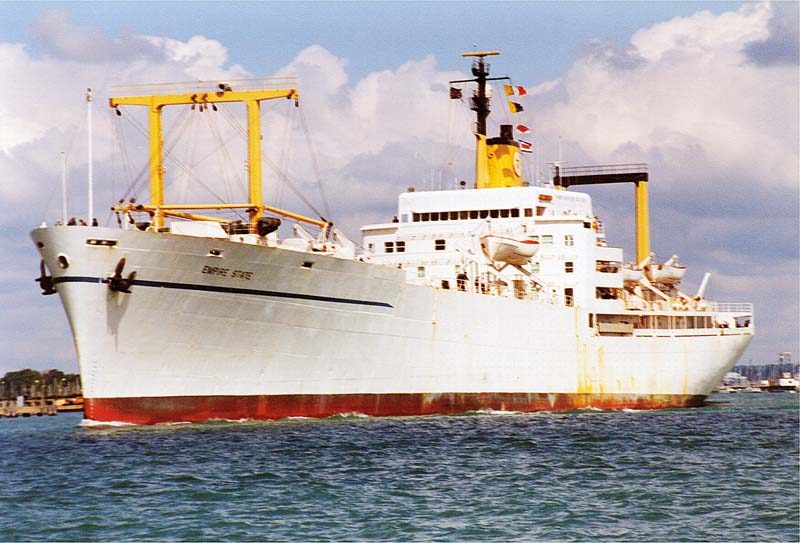
The Port Of Houston
The busy Port of Houston is a go-ahead port that is the second largest in the United States with 25 miles of quays and a cargo throughput of 220 million tonnes of cargo and 3.6 million TEU of containers per annum. The New Orleans area to the east of Houston is the largest port in the country in terms of cargo throughput at the Port of South Louisiana. Port of Houston cargo tonnage is almost all petroleum related, with several refineries along the Houston Ship Channel, and also has two separate container terminals, one at Buffalo Bayou and the other at White Oak Bayou. The port is very much a man-made port with the Houston Ship Channel having a draft of 45 feet and connecting the port to the Gulf of Mexico, with the port relying on the slow moving Buffalo Bayou river, which runs for fifty miles into the San Jacinto river, which in turn flows into the Gulf of Mexico. The port grew into prominence after the disastrous hurricane and storm surge at Galveston in 1900, and today handles ten thousand ships and over 200,000 barges per annum.
The Port of Houston is reached after a crossing of twenty miles of Galveston Bay and Trinity Bay, and after passing Morgan’s Point to port and the Baytown refinery of Exxon to starboard a vessel is turned sharply to port into the Buffalo Bayou with the historic San Jacinto Battleground State Site and the Battleship Texas State Historic Site on the corner of the bayou.
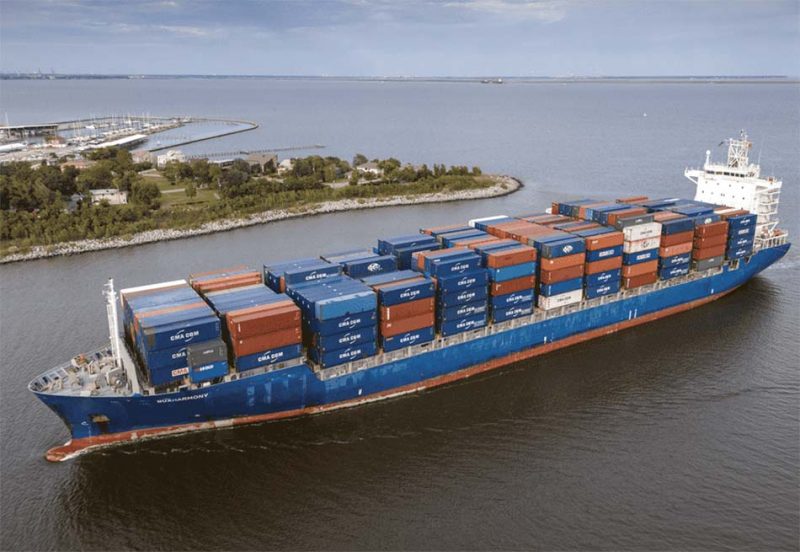
History of the Port Of Houston
The town of Houston was laid out in 1836 by John Kirby and Augustus Chapman Allen at the head of the Buffalo Bayou, a shallow waterway and only used by barges after unloading cargo at Galveston. The first coastal steamer arrived in the port in 1837 and the channel proved dependable enough for navigation for the cotton trade. Early ‘lifting towers’ were built on the bayou for the shipment of cotton and grain, with cotton brought to the port by barge and steamboat and then moved down to Galveston to be transhipped into ocean going vessels. Imported goods were shipped northwards into the Texan interior after the railroad arrived to speed cargo unloaded after transit of the Houston Ship Channel. The State of Texas joined the United States of America in 1845, transferring from Mexico, and free wharfage was then given to shipowners in return for keeping the channel open to shipping. Houston was still very much dependent on this 20 mile channel across Galveston Bay to reach the open sea.
The American Civil War slowed progress in attempts to increase cargo tonnage by bypassing the Port of Galveston. The Port Authority of Houston has very much made up for this today, as 150 years later it owns, manages and leases the public terminals of the port, including the general cargo terminals at the Turning Basin, Barbour’s Cut and Bayport Container Terminals with a total of forty cargo wharves. The Buffalo Bayou Ship Channel Company was formed in 1869 by Houston merchants, but little Government money was available to turn the Buffalo Bayou into a navigable waterway of width of 100 feet and a depth of at least six feet. The shipping magnate Charles Morgan acquired the Buffalo Bayou Ship Channel Company in 1874 and over the next two years dredged a channel from Galveston Bay to a site near Houston that today is known as Morgan’s Point on the port side as one enters the port.
In September 1876 the first ocean going vessel arrived in the Port of Houston, and in 1890 the U.S. Government purchased the Galveston Bay Ship Channel and the fledgling port. A deep water port for Houston was advocated by the U.S. Rivers and Harbours Committee as early as 1897, and this began to become a reality in late 1900 after the Galveston Hurricane and the discovery of oil at Spindletop in Texas a few months later. The oil export boom of Texas created the necessary impetus to build up the Port of Houston and dredge a deep water channel across Galveston Bay. The Port of Houston Authority was established in 1911 by the Texas Legislature as a seven member Port Commission, who are appointed by elected area officials, a system that continues in use today. The Port Authority issued $1.3 million in bonds and the dredging of the Houston Ship Channel was completed to a depth of 25 feet by 1914.
A ceremony to mark the opening of the Houston Ship Channel was held on 10th November 1914 at the Turning Basin with thousands of people attending the event, which featured a 21 gun salute. President Woodrow Wilson fired a cannon via remote control from his office in Washington (DC) to officially open the channel, and a band played the national anthem from a barge in the centre of the Turning Basin. Two deep sea vessels had plenty of room to navigate the channel, one inbound and one outbound.
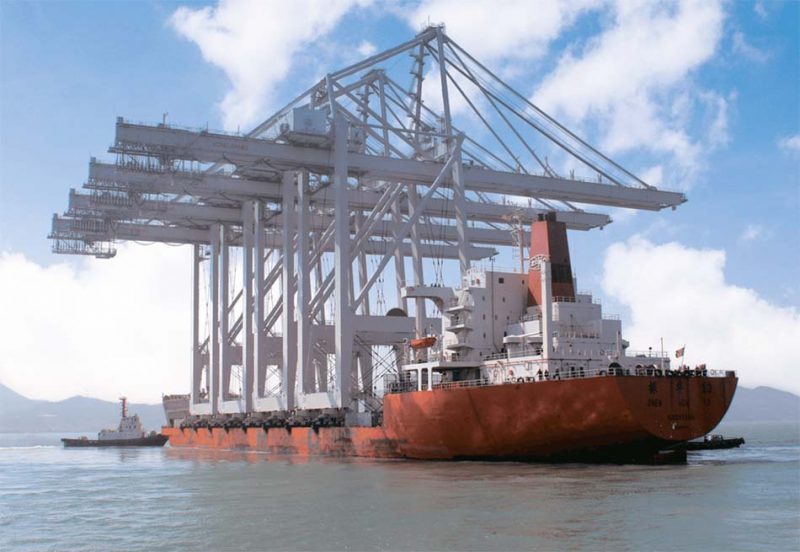
Cargo wharves and docks were built all along the Buffalo Bayou, and later several oil refineries were built including one for Standard Oil (Exxon) at Baytown on the starboard side of the channel after passing Morgan’s Point when entering port. Houston became the largest port in Texas in 1930, surpassing both Galveston and Port Arthur, and the second largest port in the country in 1937 after New York in terms of cargo handled. The port had several bunkering facilities, as well as miles of docks and wharves with warehouses and grain elevators and all of the other facilities of a very big port.
The Port of Houston played an active part in the shipment of war munitions and in the building of ‘Liberty’ standard ships. The Todd Houston Shipbuilding Corporation began the construction of these workhorses at a six berth yard at Irish Bend Island at Houston in late 1941.
The yard was one of the original nine yards that were contracted to build ships in different parts of the country, with a total of 65 slipways to build 260 ships in the first wave of construction along with yards at Portland (Oregon), South Portland (Maine), Todd California, and the California Shipbuilding Corporation yards. The first keel of a ‘Liberty’ ship was laid at Houston in early 1942 and was completed as Sam Houston in May 1942, average building time to trials being 132 days. A total of 208 ‘Liberties’ were built at Houston to greatly help the war effort, with the last to sail down the Galveston Bay Ship Channel making the passage in late March 1945.
There was another shipbuilding yard during World War II at Houston in the Brown Shipbuilding Company, located at the junction of the Houston Ship Channel and Green’s Bayou. It was founded in 1942 as a subsidiary of Brown and Root by the brothers Herman and George R. Brown to build naval ships for the U.S. Navy. A useful output of a dozen submarine chasers and 61 destroyer escorts were completed, with many of the latter taking part in the defeat of Japanese naval forces off the Philippines. After the war in 1949, the yard was sold to the Todd Houston Shipbuilding Corporation to continue with much shipbuilding in post-war years until Todd Houston closed the yard in 1985. The yard was once again used by Brown and Root, this time for barge construction and repair, and for building oil support ships and oil rigs for the booming Gulf of Mexico offshore oil business. The yard helped Brown and Root to fabricate the $200 million contract in 1961 to build the Manned Spacecraft Centre for NASA in Houston, an order of some magnitude.
Post-War Years
The Port of Houston played an important part in the development of container shipping in the post-war era. The first container ship sailed from New York and New Jersey and arrived at Houston in April 1956 for container pioneer and trucker Malcolm McLean. The Port Authority opened the Houston World Trade Centre in 1962 as a central location for importers, exporters and shippers with international connections. The Galveston Bay Ship Channel was deepened to forty feet in the same year, and the mandate of the Port of Houston from the U.S. Government was modified on 1st January 1958 to include the fostering of regional Texan economic activity.
The Port of Houston was receiving 4,500 ships per annum in the 1970s, and the first container ship terminal was opened at Barbour’s Cut in 1977. Double stack container trains began to be used in 1981 as the volume of containers passing through the port quickly grew in magnitude and handling costs needed to be reduced.
One of the main features of the self contained Jacinto Terminal in the Port of Houston is its fully automated cargo handling for bagged goods and unitised cargoes. This is the only such facility in the country and began in use in 1990 by using fast loading Spiralveyors. These have computer controlled conveyor systems which can be stopped immediately at any time to prevent damage to bags and cargo. These systems greatly reduced the cost of loading and thus give quick vessel turn around, and are greatly helped on the landward side by the use of extensive rail trackage and the 150 railcars that are owned by the port.
At the Millennium, container throughput had easily passed the million containers per annum figure, and the port operated 43 cargo wharves, 6 container terminals and wharves, 5 oil bulk wharves, with the whole area of the port using a multi-site waste disposal system, again the first such port system in the country. At the beginning of the year of 2000, a $387 million bond was issued for the construction of the 935 acre Bayport Container Terminal on land already owned by the Port Authority along Galveston Bay. The Port of Galveston had long been overshadowed by its landward rival, and while the big Bayport Container Terminal was being constructed, the Galveston Container Terminal was taken over to help throughput. Any hope of a merger of the two ports was extinguished in 2001 iny a referendum by the residents of Galveston.
Bayport Container Terminal
The Bayport Container Terminal has seven berths with a capacity throughput of 2.3 million TEU per annum. It has 376 acres of container yard and a 123 acre intermodal rail facility. It features electronic data interchange and a computerised inventory control system that tracks the status and location of each container. Road access to and from Texas Highway 146 and substantial intermodal truck and rail access is provided. The terminal was in full operation to take over some of the container trade from New Orleans when Hurricane Katrina blew in to temporarily reduce the operations of that port in 2005. The Bayport Ro-Ro Terminal opened on 13th December 2016 with a delivery of 428 Fiat cars on the Grimaldi ro-ro Grande Sierra Leone, with the Auto Warehousing Company handling the onward storage and delivery of the vehicles.
Barbour’s Cut Container Terminal
This terminal has six berths with over six thousand feet of continuous quay, a ro-ro ramp, a LASH dock, 230 acres of paved marshalling area, 255,000 square feet of warehouse space, and an intermodal truck and rail terminal via a 42 acre rail area with four working tracks and spurs, each of 2,700 feet in length. The alongside depth at the Barbour’s Cut and Bayport Container Terminals, and the Houston Ship Channel, were deepened to 45 feet in 2011 in a $68 million investment as part of a five year investment of $1.2 billion that would include a 300,000 square feet refrigerated cargo cold store at the Bayport Container Terminal, which was in full operation in 2017. The Port of Houston will thus remain at the forefront of American ports as the second largest port in terms of cargo throughput for many years to come.

Breakbulk and Project Cargo
The Port of Houston is a leader in ocean transportation handling with its general cargo terminals stretching a few miles downstream of the Turning Basin. The breakbulk cargo terminals are designed to handle a wide variety of cargo types and customer needs from grain to steel and heavy lift project cargo e.g. wind turbines and blades. All heavy and bulk cargo can be stored in areas adjacent to the wharves prior to or after shipment.
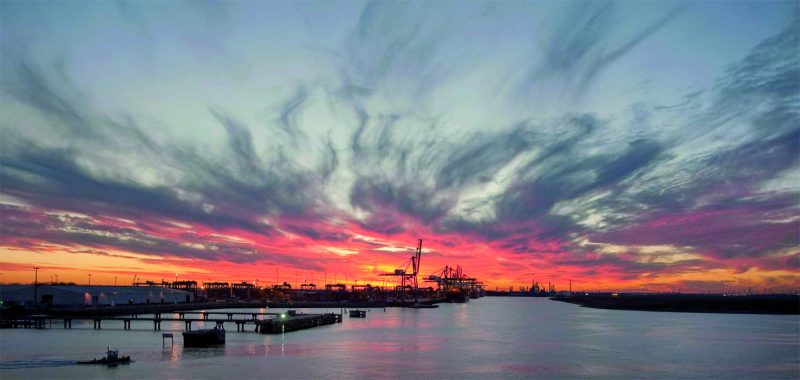
Jacintoport International LLC
Jacintoport International LLC is a self contained 62 acre terminal operating within the Port of Houston to give a very fast turnround of containers, bags and bagging systems located at Jacintoport Boulevard. General and project cargo are also handled on an eight acre concrete apron in a dock of length 1,830 feet with 550,000 square feet of warehouse space and an alongside depth of forty feet. Jacintoport offers a wide variety of services for many clients including Seaboard Marine of Miami with a fleet of ninety vessels including four new sisters of 1,600 TEU capacity completed by the Shandong yard in China as Seaboard Pacific, Seaboard Chile, Seaboard Peru and Seaboard America. This quartet are equipped with three cranes of 120 tonnes capacity (240 tonnes capacity if two are used in tandem) on their services from Miami to Houston, Cartagena, Kingston (Jamaica), Panama Canal, and ports in Colombia, Ecuador, Peru and Chile. The features of the Jacintoport Terminal include:-
- Full computer inventory control of all cargo
- Project cargo handled up to 300 tonnes
- Stripping and stuffing of containers
- Specialised cargo handling equipment including for bags and bagging
- Customs Bonded Facility with FTZ (Free Trade Zone) capacity
- Packaging and storage of resin materials
- Grain and rice cargo handling to and from bags
- 45 acres of storage area available
- Yard stevedore equipment including hustlers, forklifts, tractors and trailers
- Covered rail wagons on landward side of terminal
- Computerised tracking and inventory Systems
Postscript
Galveston was immortalised in the song of 1969 sung by Glenn Campbell and written by Jimmy L. Webb of dreams of Galveston with its ‘crashing seawaves and blowing seawinds’. Galveston is still very much a seaside town with many interesting tourist facilities and museums next to its two cruise terminals. However, not all of Galveston Island is built up as there is the Galveston Island State Park to enjoy, similarly at Houston there is the Buffalo Bayou Park.
The Port of Houston also has a free interesting public tour of the port on a ninety minute trip along the Houston Ship Channel on the white hulled motor vessel Sam Houston, named after the legendary military commander who led the fight for Texan independence from Mexico and its later statehood. This 95 feet long vessel first made this public tour on delivery in 1958 and has accommodation for 100 passengers with full air conditioning and lounge seating and outdoor viewing areas.

A holiday or business trip to Galveston and Houston should also take in this excellent free and unique voyage.
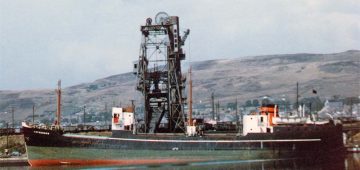



Comments
Sorry, comments are closed for this item